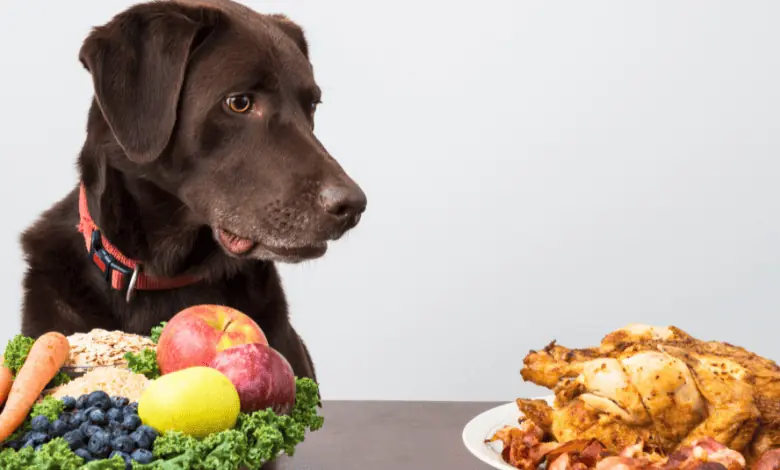
As humans, you know color means health when it comes to food. All brown and yellow and white tends to be a plate of just protein and carbs. Fruits and vegetables add that brightness to your meal and also important things for your body. Vitamins, antioxidants, and fiber are packed in colorful foods.
When it comes to your furry loved ones, why not give them that same access to health? Dry kibble can get the job done, but colorful foods can be even more beneficial for your dogs. If you haven’t considered fresh dog food, that might be a way to pack in the nutrition. There are a lot of options that can create a balanced diet for dogs. When switching to the fresh and natural route, it’s important to know what your dog can have.
There are some potential dangers and restrictions associated with certain fresh foods when it comes to canines. Don’t just give them everything off your plate. In fact, don’t feed them off your plate at all. You want to feed them food meant for them. You can choose a fresh food delivery service or to cook for your dog. If you do cook for your dog, take into account the number of calories needed for their breed, weight, and activity level. Keep reading to learn colorful foods you can share with Fido so he can taste the rainbow.
1. Red
When you think of the color red, red meats likely pop into your head. Dogs can eat beef, pork, and lamb. Beef is often the cheaper of the meats, so it makes it a budget-friendly protein for your dogs. It’s high in protein, iron, and zinc and has vitamins B3, B6, and B12. It doesn’t impact a dog’s cardiovascular system the same way it does for humans either.
Lamb and pork tend to have a higher fat content, so they can be great for active and younger dogs. If you have an older, less active, or overweight dog, these meats probably aren’t the best choice. Lamb contains protein, selenium, B3, B12, Omega 3, Omega 6, and zinc. Pork is less common for dog food. However, it still contains selenium, zinc, phosphorus, protein, B vitamins, and iron. All of these nutrients are beneficial for your pup.
Cranberries and strawberries are a couple fruits that can be good for your dog as well. Cranberries aid in the prevention of urinary tract infections and have a lot of antioxidants, vitamin C, and fiber. They can be eaten fresh or dried. Strawberries contain the same nutritional value and help with brighter teeth. Dice and cut out stems before giving these to dogs.
Red foods to avoid: apple seeds, cherries, tomatoes, and rhubarb. Cherries and apple seeds both contain cyanide-releasing compounds. Ingesting these can lead to cyanide poisoning in dogs, which can cause symptoms such as vomiting, diarrhea, difficulty breathing, and even death. Tomatoes contain a substance called solanine and rhubarb leaves and roots contain oxalates, which both can be toxic to dogs.
2. Orange
Carrots are a good vegetable for dogs and are high in fiber and contain vitamin A and beta-carotene. You can either dice to add to their food, or give your dog a whole carrot to use like a chew toy. They are helpful for eyesight and dental care. You can also give your dog mangos and oranges, but note some dogs don’t like the citrus smell and taste.
Embrace your love of fall with your fluffy friend and share the pumpkin. It’s great for your dog’s digestion and skin. Like carrots, pumpkin is high in fiber, and contains vitamin A and beta-carotene. There are several options for serving, just make sure it’s not sugar added. You can give it to your dog fresh or cooked and mashed. Canned is okay here too for a quick and easy option.
Orange foods to avoid: peaches and apricots. Both peaches and apricots have pits that contain cyanide-releasing compounds similar to those found in cherry pits and apple seeds. They’re also very high in sugar, so even in moderation, they can cause digestive issues.
3. Yellow
Be mellow and embrace the yellow! Bananas are great for dogs for similar reasons as for humans. They have a lot of potassium, are rich in vitamins, and add fiber and copper to their diet. Be sure to peel it when serving. Cut into small pieces to reduce any choking risk.
Cantaloupe is another yellowish option your dog can enjoy. Cantaloupes have a high water content, fiber, and have vitamins A and C. You might be noticing a trend in fiber content for many of these natural foods. That helps keep your dog’s bowels regulated. To serve up cantaloupe, take off the rind and seeds and cut it into small pieces.
Yellow foods to avoid: corn on the cob. Corn cob is hard and indigestible. If a dog eats a large piece of corn on the cob, it can become lodged in their throat or digestive tract, leading to choking or a blockage. This is a severe and potentially life-threatening emergency that may require surgical intervention to remove the obstruction. Even when a dog manages to chew and swallow small pieces of corn on the cob, it can cause stomach upset. Corn cobs can also splinter into sharp pieces when chewed, which can injure a dog’s mouth, throat, or internal organs.
4. Green
Green is a big category of healthy options for dogs. Broccoli, green beans, cucumbers, pears, brussel sprouts, celery, peas, and spinach are all options to go green. These options are great to dice or pulse to mix in with meats. Cut off the pieces you wouldn’t eat and remove the seeds.
Green beans and peas have a lot of variety and options for use. Green beans can help maintain and balance weight. They have iron, fiber, and vitamins C and K. Make sure there’s no added salt, but you can serve them from frozen, fresh, or canned.
Green foods to avoid: chives, onions, and garlic. These members of the allium family contain certain compounds that damage a dog’s red blood cells. This can lead to a condition called hemolytic anemia. Even small amounts of chives can be toxic to dogs and may cause symptoms such as vomiting, diarrhea, abdominal pain, and, in severe cases, organ damage.
5. Blue and Purple
Blueberries are a superfood. They are rich in antioxidants and loaded with fiber. Treats with blueberries or blueberries and yogurt can be yummy. You can also toss your dog a washed blueberry to catch as a treat.
Blackberries are also good additions to your dog’s diet. They also have antioxidants, low sugar and calories, and a lot of fiber, vitamin C, and manganese. Older dogs with aging joints reap the benefits of this as well with the anti-inflammatory components.
Purple food to avoid: Plums, currants, raisins, and grapes. These foods can be toxic. Grapes, whether fresh or dry, can lead to sudden kidney failure.
You and your dog can both live healthier lives by eating more colorful foods.You could start slow by swapping treats with produce. And if you don’t want to be your dog’s personal chef, check out fresh options in store or online. By making mindful choices, both you and your dog can enjoy a healthier and happier life together.






